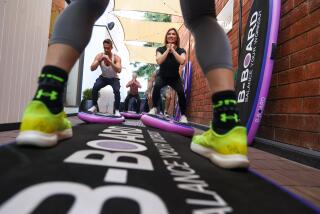New Surfer on Board
- Share via
If you have watched enough old “Gidget” movies that you are ready for some real action, push the off button on your remote and hit the beach for some sunshine and fresh air.
Once there, you could bring that reliable old shovel and spend your day digging a big hole in the sand. But why not venture out into the surf and ride the waves like those guys you always see off in the distance?
But first, here are some ins and outs of buying a surfboard.
Not all boards are alike. Some are long--called, appropriately enough, long boards. Some are short--you guessed it, the short boards. But we bet you don’t know what the medium boards are called.
No, not medium boards--that would be too easy.
Ventura Surf Shop owner Stan Fujii said you can call them short-long boards, big-short boards or fun boards. But not medium boards, unless, of course, you don’t mind being branded as hopelessly dorky.
Other fun facts: the bigger the board, the better it floats, and the shorter the board, the easier it is to turn. Same goes for width. The wider the board, the easier it floats and more stable it is but the harder it is to pivot. Thickness also adds to stability and takes away from maneuverability.
So which is better for beginners? Fujii recommends the long boards in general but says there is a lot that goes into selecting just the right board, including the height, weight, build and surf style.
He takes all those variables into account when he makes boards at his Ventura shop. Short boards--those under 7 feet--run about $335 and long boards, over 9 feet, sell for about $475.
He also sells exotic styles for as much as $4,000, but those are more art objects than boards that are going to be put into a salty ocean, he said.
Used boards can be priced as low as $50, but you get what you pay for, Fujii said.
“When you buy a used board, you have to fit the board,” he said. “When you get one custom-made, the board is made to fit you.”
It is also made to fit where you want to surf and even the season, since winter waves are usually bigger.
“If you want to surf in Hawaii, you’ll need more rocker,” said Norm Niegas, manager of Val Surf in Thousand Oaks.
That means you will need a surfboard made with a more pronounced curve or arch to help you on the steeper Hawaiian waves.
“A surfboard is a personal preference, and you need to look for certain characteristics that match who you are and where you surf,” Niegas said.
New surfboards at Val Surf range from about $340 to $550. Used boards range from $80 to $300. The average board is about 6 feet, 2 inches, and custom boards can be ordered, he said.
Kale Shannon of Surfin’ West of Simi Valley recommended that a beginner look for something wide and thick with three back fins, which add stability. A more experienced surfer might choose a single- or twin-fin board, he said.
He suggested that beginners look for something inexpensive and used because, if they are anything like he was, their surfboards will get thrashed from hitting rocks.
At Surfin’ West, new boards range from $350 to $475 with used boards from $80 to $200, he said.
Surfboards with special colors or pictures airbrushed on them cost more, said John Villela, owner of Revolution Surf Co. in Camarillo.
At his shop, new boards range from $350 to $600, with some used boards selling for $150 to $250, he said.
Villela recommends the fun board for beginners, because it offers the best of both boards.
And he has noticed a revival, with old and young surfers alike buying long boards again.
Once a beginner has picked out a board, he or she should remember the other necessities. At Surfin’ West, Villela sells spring-style wet suits for $69.95 to $120. Surfboard wax is 75 cents. Sunscreen is also a must, he said.
And while you still have your checkbook out, you might as well write one for a surf lesson or two, which can cost $20 to $40 a session.
But the most important thing you might want to add to the list is a leash, costing $20 or more, that connects your surfboard to your ankle.
“A leash will save you a lot of extra swimming,” Villela said.
It might also save you another trip shopping for the perfect surfboard.
Nancy Needham writes a weekly consumer column and can be reached at nancy.needham@reporters.net.


